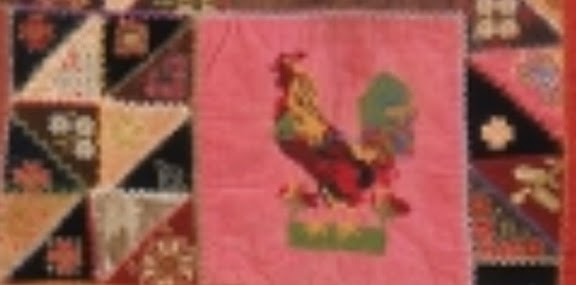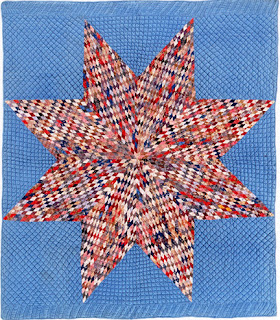Detail from an embroidered quilt, ca 1900, in the collection
of the Jewish Museum
My cousin sent an April 12, 2014 article from the Jewish Daily Forward called "Why Jews Suffer from a Quilt Complex?" Author Jenna Weissman Joselit discussed why her Jewish "home and ... parents’ home and ... grandparents’ homes were entirely quilt-free."
"East European Jews and their descendants, as I've just discovered, had little truck with quilting. Feather bedding was one thing; patchwork quilts quite another."The article:
http://forward.com/articles/196183/why-jews-suffer-from-a-quilt-complex/#ixzz2ymyvYwz4
This is true in my personal experience too. My Jewish grandmother's house (and my Irish-Catholic grandmother's house---both in New York City) were entirely quilt-free.
My Jewish grandmother loved handwork,
knitting full outfits (skirt, cardigan and shell) and
crocheting doilies similar to this by the dozens.
- One: Contemporary quilters working after 1960
- Two: Historical quilts made before 1960.
A layered patchwork textile with layers held together by quilting or tying.
Contemporary quilters working after 1960
Rosh Hashana by Linda Frost, 2010
This quilt traveled in a 2012-13 Smith-Kramer exhibit
America Celebrates! Quilts of Joy and Remembrance.
Historical quilts made before 1960
The Reiter/Freidman family Baltimore Album quilt
1848-1850, Baltimore
Collection of the American Folk Art Museum
One of three similar Baltimore album quilts attributed to Baltimore's Jewish community about 1850.
Read more here:
http://www.folkartmuseum.org/?p=folk&t=images&id=4268
Quilt photographed during the Kansas Quilt Project
We looked at the quiltmaker's religion. About 59 percent of the quilts were identified as being made by a quiltmaker with a known religious affiliation. The number: about 7,700 quilts. The highest percentage (22.5%) was made by Methodists followed by people identified as generic Christians, then Roman Catholics, Baptists, Presbyterians and Lutherans---not surprising as these specific denominations ranked highest among Kansans in general in the 1980s.
Fundraising quilt made by members of the Sunday School,
First
Methodist Episcopal Church, Topeka, Kansas, 1883.
Collection of the Kansas State Historical Society.
Church members paid a dime to have their names included.
The contrast between Roman Catholics and Methodists was interesting, however. Catholics made up the highest percentage of Kansans (34.6%) at the time, with Methodists at 26.9%. Yet Catholics did not make quilts in proportion to their numbers either in 1886 or 1986. Catholics made 7% of our total; Methodists over three times as many.
I did the accounting and was surprised to find that of all those quilts only six were made by Jews: Six quilts made by 1-1/2 quilt makers identifying themselves as Jewish. I know it was 1-1/2 because I was the half and a friend was the whole. We both began after 1960.
The Kansas Quilt Project also asked about quiltmakers' ethnic origins and found over 8,000 identifications. British heritage was first with 41% reporting that background, German ethnicity was a close second at 38% and then the numbers dropped to 13% for Scandinavian, 5% for French and 1% for Czech. Ethnicity such as Italian, Mexican, Amish and Jewish were insignificant at less than 1% each.
Fundraising quilt made by women of the
First Baptist Church, Jamestown, Tennessee
1937-1939. From the Quilt Index.
Community members paid a dime for each embroidered name
raising $22.10. The quilt then sold for $10.00. The $32.10 bought chairs
for Sunday School.
My theory at the time of writing the book on the findings of the Kansas Quilt Project:
"Protestant church activities, such as Sunday School quilts and Ladies' Aid Society quilting groups traditionally were a strong influence on quilting."
Lititz, Pennsylvania, 1942
Photo by Marjory Collins. Courtesy of the Library of Congress
The caption: "The Moravian sewing circle quilts for anyone at one cent a yard of thread and donates the money to the church."The Moravians in the photo, like many Protestant women's church groups, raised money for church improvements and maintenance by taking in quilting, an activity still carried out in church basements. Women also raised money by charging for signatures, and by raffling (if such gambling was allowed) and auctioning quilts.
Quilt auctions raise significant funds for the
Mennonite Relief Services.
Based on data from the Kansas Quilt Project and personal observation I would have to agree with Jenna Weissman Joselit that quiltmaking was not a popular activity among Jewish women in the past.
There are, of course, exceptions to the rule. Bertha Stenge was one of the most prominent quiltmakers of the 1940's and '50s, winning national prizes with her work.
Bertha Sheramsky Stenge (1891-1957)
Bertha Stenge, The Quilt Show
Collection of the Art Institute of Chicago
See more of Stenge's quilts here at the Art Institute
And read a biography here:
http://www.museum.state.il.us/ismdepts/art/collections/daisy/biography.html
Berger/Miller quilt
Another of the 1850 Jewish Baltimore Albums
from the collection of Jane Katcher
Bertha Neiden 1914
Bayla Schuchman, born in Gorodish, Russia, emigrated to the U.S. in 1909. By 1914 when this photo was taken her name was Bertha and she was Americanized enough to enter her quilt in the Nebraska State Fair. Her wool patchwork seems to have more in common with the European tradition of tailor's patchwork or intarsia patchwork than the American quilts of her era.
Read more about Bertha Neiden and her quilt:
And read more about wool intarsia quilts here at this post I did a few year ago:
Quilt dated 1880 by an unknown maker in classic American applique style.
One does not find this style of bedding in traditional European cultures.
Quilt historians have looked at quilts and immigrants from many angles. The consensus is that the typical American patchwork quilt derived from a few sources, particularly the tradition of patchwork in India and its trading partners Holland and Britain, combined with a widespread European/Asian tradition of quilted bedding.
"Armenians make quilts Alexandropol,"
probably early 20th century, photo from the Library of Congress
Japanese quilted bedding about 1930
from the Library of Congress.
People all over the world have slept under and on quilted and tied bedding.
American quilts are distinctive in their combination of the two techniques, so distinctive that we can view the acquisition of the techniques and designs as a sign of American acculturation.
European immigrants from the Pennsylvania Germans of the 1600s to the Ashkenazi Jews at the turn of the last century did not bring the patchwork quilt tradition with them.
In the early-19th century the Pennsylvania Germans adapted the bedding of their "English" neighbors to their traditional design sense. It is probably this combination of German folk arts and British bedding format that had the most significant impact on the traditional American quilt.
Unfinished top by Mary Jane Lewis Scruggs
Collection of the Kansas Museum of History
We can see much Germanic design influence in the flat, stylized flowers, red and green colors and mirror-image symmetries in Scrugg's top, evidence of the Pennsylvania-German impact in the American quilt. It is also evidence of this particular African-American quiltmaker's American culture. She was born right after the Civil War to former slaves.
Read more about her quilt top here:
Embroidered quilt, ca 1900, in the collection
of the Jewish Museum
The Museum's caption:
Quilt. Russia and United States, c. 1899 Velvet: embroidered with wool, silk, and metallic thread; glass beads 81 1/2 x 65 in. (207 x 165.1 cm) The Jewish Museum, New York Purchase: Judaica Acquisitions Fund
Cross-stitched embroidery detail showing
European dress and dance
Detail showing cross-stitched rooster
and seam-covered patchwork on the patchwork triangles.
Looking closer at the embroidery I realized that much of it is cross-stitched pictorial work, not typical of the American crazy quilt, which usually features irregular pieces, outlined pictures,satin stitches and seam-covering, linear stitches.
An American crazy quilt
Perhaps the cross-stitch embroidery was done in Russia and the pieces assembled into patchwork in the U.S., a rather unusual example of Americanization in a single quilt.
See another quilt in the Jewish Museum's collection here:










































































